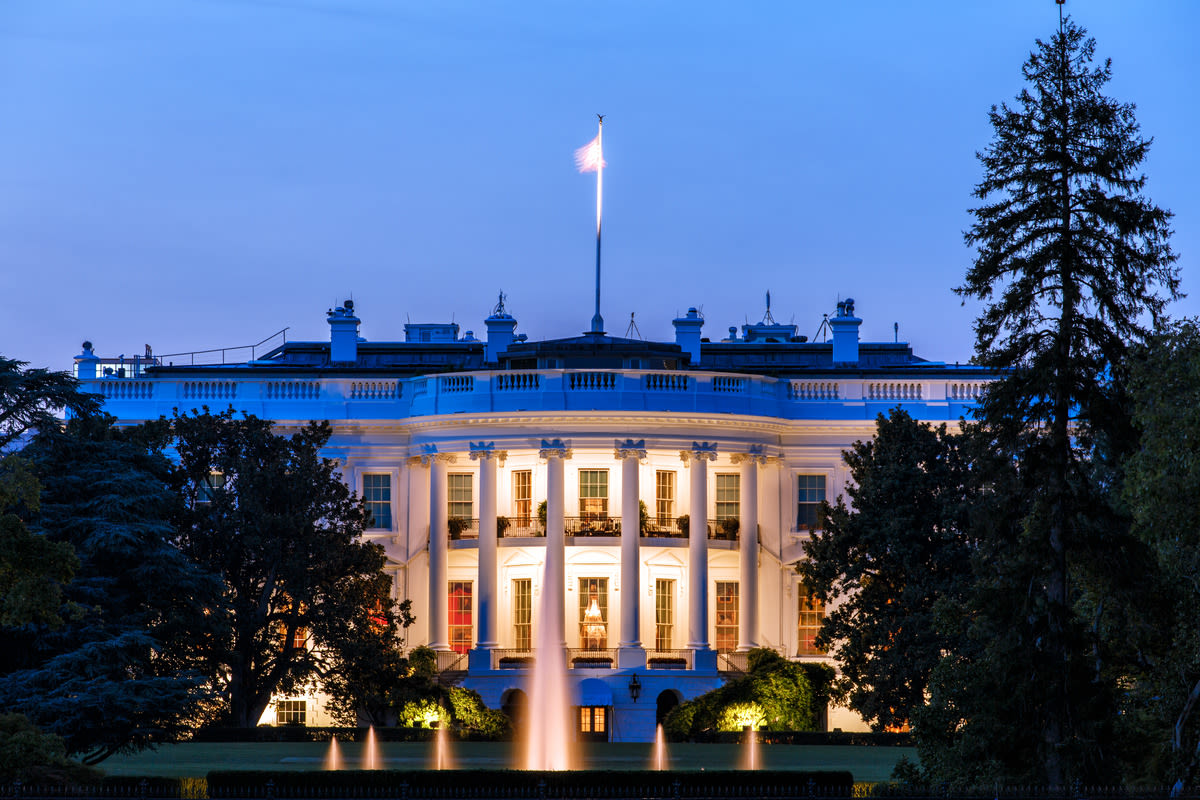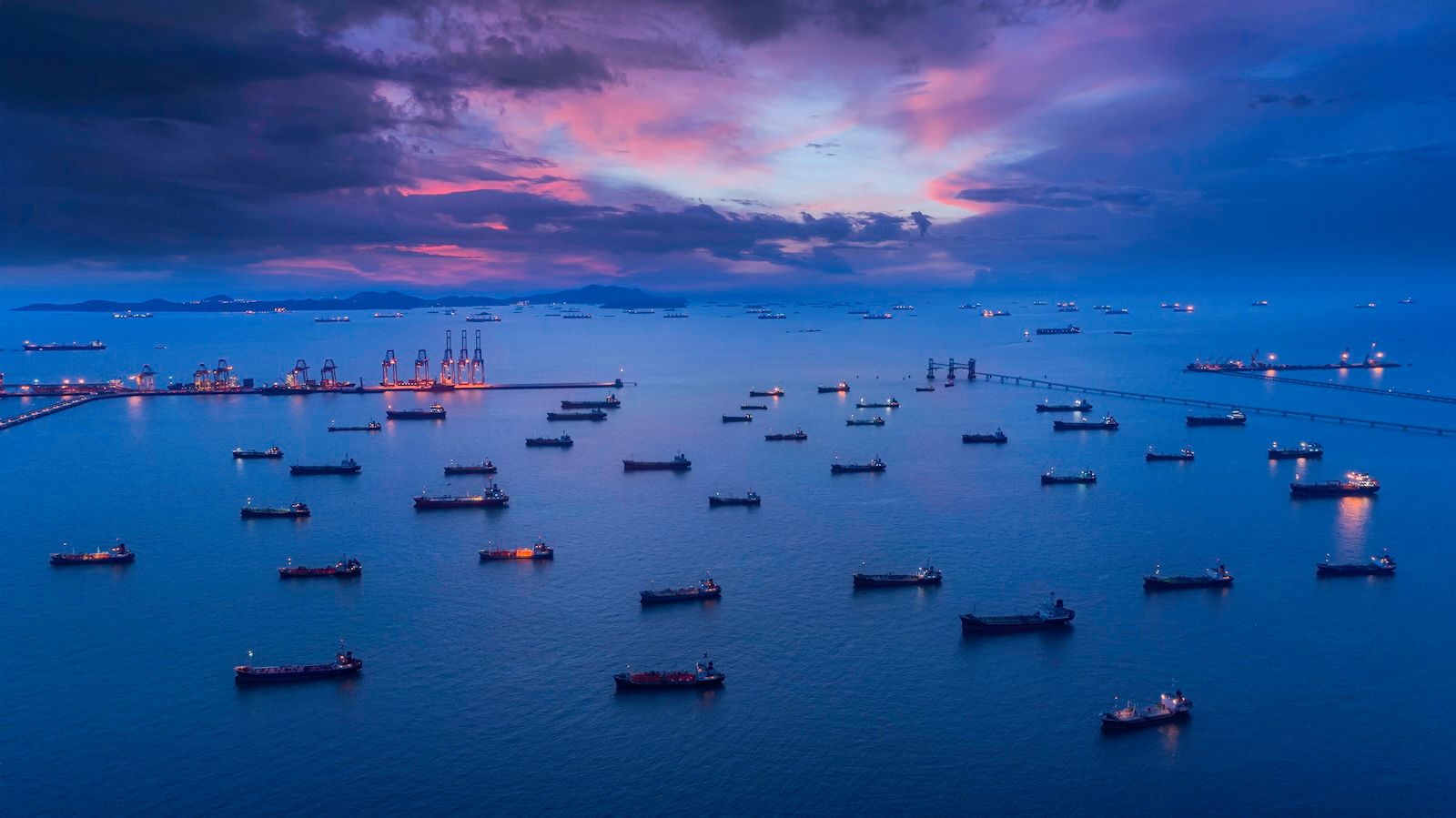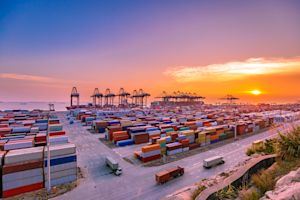
Global Logistics Update
New Reciprocal Tariffs Take Effect; Typhoons Cause Delays on TPEB and FEWB
North America vessel dwell times and other updates from the global supply chain | May 17, 2023
Global Logistics Update: August 7, 2025

Trends to Watch
Talking Tariffs
- Modified Country-Specific Reciprocal Tariffs Take Effect: Effective at 12:01 a.m. ET today (August 7), nearly 70 U.S. trade partners are now subject to the modified reciprocal duty rates laid out in President Trump’s July 31 executive order.
- Any nation not listed in the executive order will be subject to a 10% baseline reciprocal tariff, with the exception of China and Canada.
- Eligibility for the reciprocal in-transit exception: Goods must have been loaded onto a vessel at the port of loading and in transit on their final mode of transportation before August 7 at 12:01 a.m. ET, and arrive before October 5 at 12:01 a.m. ET.
- Goods determined to have been transshipped to evade duties will be subject to a 40% tariff.
- Calculate and analyze these tariff impacts in real time with the Flexport Tariff Simulator.
IEEPA Tariffs in Effect as of Today (August 7, 2025):

- President Trump Signs Executive Order Imposing an Additional 25% Tariff on All Indian Imports: On August 6, President Trump published an executive order that will levy an additional 25% blanket duty on India beginning August 27, just days after imposing a 25% reciprocal tariff scheduled for August 1.
- According to the executive order, the U.S. is imposing the second 25% tariff in response to India’s “importation of certain oil products of Russian origin into the United States.”
- Indian-origin goods in transit on their final mode of transport before August 27 and “entered for consumption, or withdrawn from warehouse for consumption” before September 17 will be exempt from the second 25% tariff.
- Depending on exact shipment departure and arrival dates, some Indian-origin goods will face an effective duty rate of 50%. For a breakdown of applicable duties based on shipment timelines, check out our live blog update.
- President Trump Announces Potential 100% Semiconductor Tariff: On August 6, President Trump stated that he plans to impose a 100% duty on semiconductor imports, but intends to exempt businesses that manufacture in the United States. He did not indicate a timeline for implementation.
- President Trump Suggests Possible Pharmaceutical Duties: On August 5, President Trump indicated that he may announce tariffs on pharmaceuticals as soon as next week. In an interview with CNBC, President Trump stated that pharmaceutical tariffs will be “initially small,” but “in one year—one and a half years, maximum—it’s going to go to 150%, and then it’s going to go to 250%.”
- EU Delays Countermeasures Against U.S. Tariffs: On August 4, the EU announced that it would delay its countertariffs of up to 30% for six months. These countermeasures were originally set to take effect today.
- President Trump Modifies Tariffs on Canada: On July 31, President Trump published an executive order increasing IEEPA “fentanyl” tariffs on Canadian imports from 25% to 35%, effective August 1.
- Exemptions for USMCA-compliant goods remain unchanged.
- The current tariff stacking order also remains unchanged.
- Goods determined to have been transshipped to evade duties will be subject to a tariff rate of 40% in lieu of the 35%, along with applicable fines or penalties.
- U.S. and China Near August 12 Trade Deal Deadline: The latest round of U.S.-China trade talks wrapped up on July 29, just two weeks before the existing 90-day tariff agreement expires on August 12. After last week’s talks, U.S. and Chinese officials had agreed to push for an extension of the temporary tariff agreement, though President Trump has yet to make a final decision on the matter. If the two nations do not finalize an extension or a trade deal by August 12, U.S. tariffs on Chinese goods will revert back to 145%, while Chinese tariffs on U.S. goods will revert back to 125%.
Ocean
TRANS-PACIFIC EASTBOUND (TPEB)
- Capacity and Demand:
- Market demand in August is flat, with Southeast Asia ports continuing to post higher total loadings than China ports.
- Capacity is at 70-80% of normal levels. Despite these reductions, the market is still experiencing overcapacity compared to overall demand.
- Space availability for shipments is open.
- China ports are experiencing a delay of two to three days due to Tropical Storm Co-may. Carriers have introduced schedule recovery programs to bring vessels back online. Shippers should expect unannounced blanks and vessel bunching in China, with cascade impacts to other Asia ports like Busan.
- Equipment:
- Equipment availability has improved slightly since late July. However, equipment shortages are still a primary concern for carriers like CMA and HMM, while other carriers are experiencing better conditions.
- Freight Rates:
- Freight rates for August were mitigated this week. This is attributed to flat demand and the full removal of the Peak Season Surcharge (PSS) from the fixed market for the month of August.
FAR EAST WESTBOUND (FEWB)
- Capacity and Demand:
- In August and September, FEWB trade capacity will remain sufficient. Average weekly capacity in the first half of August is 304,000 TEUs, dropping to 290,000 TEUs in the second half of the month. Additionally, Evergreen (EMC) and Maersk are adding a combined ~46,000 TEUs via extra loaders in the second half of August.
- On the demand side, as the traditional peak season (July–August) draws to a close, volume growth is slowing and overall demand has softened.
- Meanwhile, typhoon impacts across Far East ports of loading (POLs) have caused vessel delays, helping carriers maintain a high vessel loading ratio and keeping supply and demand relatively balanced.
- Freight Rates:
- Carriers have slightly lowered Freight All Kinds (FAK) rates in early August, bringing spot rates back to the second half of July’s levels. This was driven by extra loader capacity additions and lower-than-expected demand growth, especially among carriers with a higher FAK share.
- Ongoing vessel delays due to typhoons, unclear blank sailing plans for the second half of August, and unshipped peak season cargo limit the possibility of large rate drops. FEWB rates are expected to remain at high levels in the coming weeks.
TRANS-ATLANTIC WESTBOUND (TAWB)
- Capacity and Demand:
- Antwerp continues to face extreme congestion—currently the worst since Covid‑19—with dwell times now exceeding nine days and yard utilization over 92%.
- Rotterdam, Hamburg, and Bremerhaven remain under pressure, with yard utilization at 85–88% and vessel delays of three to five days.
- In the South Mediterranean, ports like Piraeus, Genoa, and Valencia continue to report yard congestion and wait times between three and six days, with little improvement from July levels.
- Low river levels on the Rhine and Danube, labor strikes in Germany, and intermittent rail disruptions in Central and Eastern Europe are further straining inland logistics.
- The blank sailing rate is hovering around 5–6%, relatively flat month over month. Overall capacity remains stable, but some carriers are adjusting rotations to avoid congested terminals.
- Equipment:
- Shortages persist in Austria, Slovakia, Hungary, Southern and Eastern Germany, and Portugal, especially for 40’ HC and chassis units. Extended equipment turnaround times remain, given inland congestion and slow repositioning from main ports. No meaningful recovery in availability is expected through mid-Q3.
- Freight Rates:
- In North Europe and the West Mediterranean, most carriers have further postponed PSSs until late Q3, citing stable demand. East Mediterranean markets (notably Turkey and Israel routes) are seeing GRI announcements for early September.
INDIAN SUBCONTINENT TO NORTH AMERICA
- Capacity and Demand:
- Capacity to the U.S. East Coast remains steady into August, with only two blank sailings announced across the month in total for the major Northwest India to U.S. East Coast corridor.
- Capacity to the U.S. West Coast is widely available, given the ongoing oversupply impacting major TPEB services that move cargo from the Indian subcontinent to the U.S. West Coast.
- Freight Rates:
- For cargo moving to the U.S. East Coast: Heading into August, rate levels have held. There is a lack of typical major peak season demand to support rate increases, especially in light of capacity being re-injected into the Indian subcontinent to U.S. East Coast trade.
- For cargo moving to the U.S. West Coast: Oversupply has drastically reduced rate levels in August.
- Exports from Pakistan continue to see elevated cost and transit times due to additional feeder services needed to service the country in light of the India-Pakistan conflict.
- With this week's executive order on India, the impact of the evolving tariff situation on demand and capacity is extremely fluid.
Air
WEEK 30: JULY 21 - JULY 27, 2025
- China and Hong Kong to the U.S.: Tonnages rebounded in Week 30 (July 21-27) with a +4% week-on-week (WoW) increase from China and a +5% rise from Hong Kong, after Typhoon Wipha led to hundreds of cancellations the week prior.
- China and Hong Kong to Europe: China to Europe tonnages dipped by a further -2% in Week 30 after declining -6% WoW the previous week. Out of Hong Kong, tonnages slightly bounced back, exhibiting a +2% WoW increase in Week 30.
- Spot Rates from the Asia-Pacific to the U.S.: Asia-Pacific-to-U.S. spot rates were stable, rising 2% WoW to $4.89/kilo. South Korea was an exception to this trend, with continued volatility—including a 29% increase from Week 29 to Week 30, reaching $6.01/kilo, after a -17% decrease the week prior. By contrast, the Asia-Pacific to Europe was stable, declining -2% WoW.
- An Upward Trend on the TPEB Market in Early August: In the first days of August, we are seeing an upward trend in the TPEB market, with an uptick of $0.50-$1/kilo. Notably, with the new 20% U.S. tariff on Taiwanese imports taking effect on August 7, air cargo demand is surging further upward in this market as shippers accelerate movements ahead of the deadline, almost reaching $9/kg for express service.
(Source: WorldACD and Flexport)
Please reach out to your account representative for details on any impacts to your shipments.
North America Vessel Dwell Times

Webinars
North America Freight Market Update Live
Thursday, August 14 @ 9:00 am PT / 12:00 pm ET
Navigating Peak Season: Essential Omnichannel & Fulfillment Strategies for Success
Available On-Demand
Tariff Trends 2025: Expert Insights on the New U.S. Customs Landscape
Available On-Demand
Ocean Timeliness Indicator
Transit times from China to the U.S. West Coast and China to North Europe both experienced modest decreases, while the route from China to the U.S. East Coast saw a notable increase.
Week to August 4, 2025
Transit time from China to the U.S. West Coast decreased by 0.5 days, falling from 34.5 to 34 days. The China to North Europe route saw a 0.4-day decrease, moving from 62 to 61.6 days. Finally, transit time from China to the U.S. East Coast increased by 2.3 days, rising from 59.1 to 61.4 days.

See the full report and read about our methodology here.
About the Author






